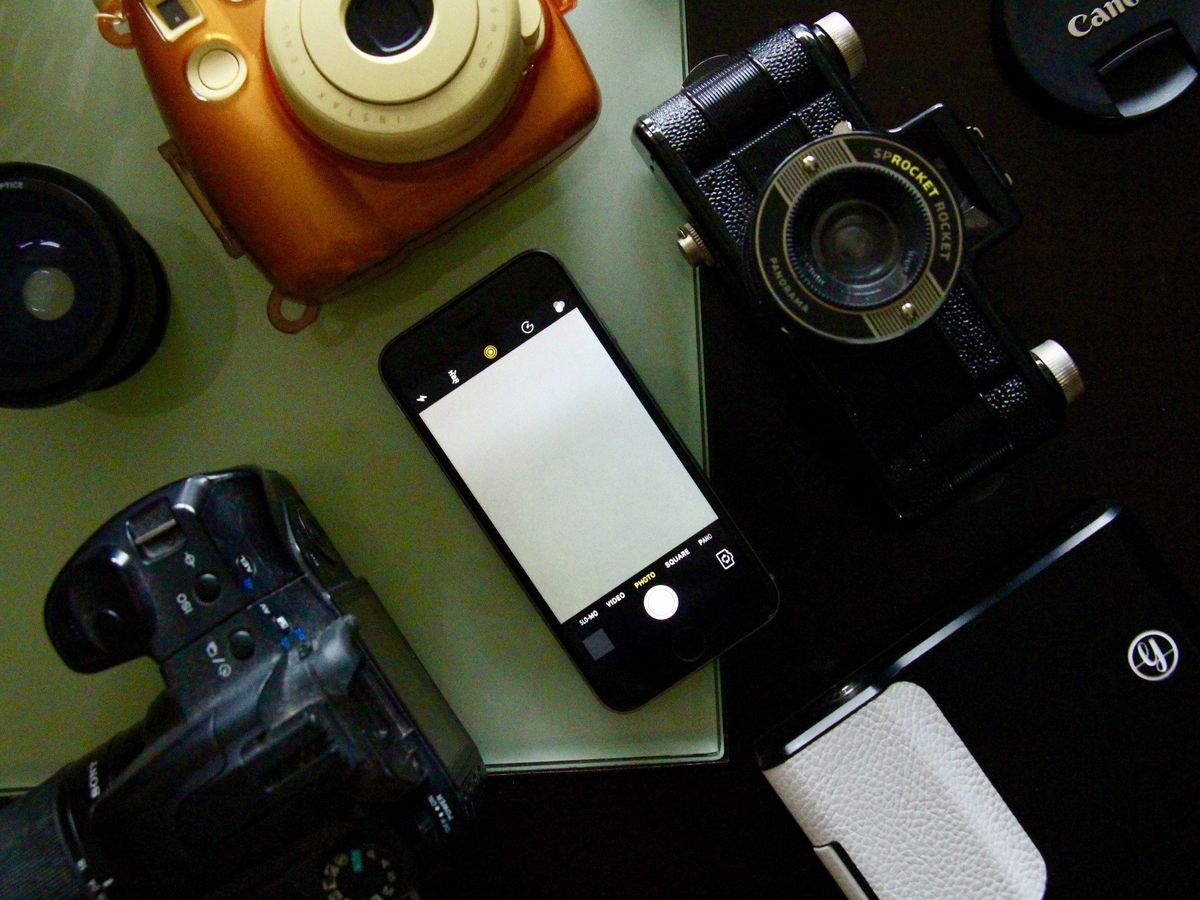Life, as seen through 73,732 digital photographs

The oldest ones are nearly 15 years old: 1600-by-1200-pixel snaps taken from my first digital camera, a Canon PowerShot. I bought that camera in October 2001 because my wife and I were about to have our first child; we knew we were about to have a life experience that really needed to be documented.
Here's how much photography has changed in the last 15 years: One of the selling points I had to make back then was the relative cost of having prints made from digital photos versus taking film to the supermarket and getting back prints. (I won the argument, because even in 2001 the economics were shifting away from film — it was cheaper to digitally print only the images that turned out well, rather than paying for an entire roll of film to be printed, regardless of quality.)
A brave new digital world

The first two years of my daughter's life are chronicled via 1.9 megapixel snaps from that Canon PowerShot. From today's perspective, it's a shamefully low-resolution camera, but at the time it was pretty good. It generated some nice 3x5 prints from Shutterfly, and there's an 8x10 print from the day my daughter was born on the wall of my house. It looks pretty great, even now.
Because I used a digital camera, I was able to post photos of my newborn daughter on the web on the day she was born, and continually update friends and relatives with new photos over the first few years of her life. Today, we have Facebook and Twitter and countless other photo-sharing services; back in 2001, there was basically nothing. I made a website, put some photos on it, and sent my friends and family the link: That was where all our family photos went.
A few months later, Apple announced iPhoto, a "digital shoebox" for all of our digital photos. It arrived just in time: For the next 13 years, I poured photos into that shoebox while Apple released software updates to try to make iPhoto more capable of dealing with the deluge. It was a race that iPhoto rarely won: Every release claimed to be faster than the one before it, and that was generally true, but by that point my library was full of thousands — and later, tens of thousands — of photos.
By 2003, the digital photography revolution was in full swing. My boss at the time gave me a bonus — but rather than cash, he offered me a Canon Digital Rebel. This was the first $1000 Digital SLR, and it dramatically improved the quality of my digital photos. Not only was it a 6.2-megapixel camera, but it had all the gorgeous optics of an SLR. It also meant that all my photos went from being 400K to 2.5MB per shot, making iPhoto groan under the strain.

That was my digital photo life for a long time, through the birth of my son and the entry of my daughter into elementary school. The idea of printing photos rapidly receded into the distance. (I started printing end-of-year iPhoto Books, and then even stopped doing that. These days I print a few large prints to hang on the wall, and everything else stays on a phone or computer screen.)
Master your iPhone in minutes
iMore offers spot-on advice and guidance from our team of experts, with decades of Apple device experience to lean on. Learn more with iMore!
Enter the iPhone
In 2007, though, I got a new camera — the original iPhone. Its sole rear-facing camera had a paltry 1.9-megapixel sensor, like the one in the point-and-shoot I'd bought six years earlier. Unlike that camera, however, the iPhone had no optical zoom or flash, and much worse optics.
But now I had a camera with me at all times — not just the times when I anticipated needing a camera.

I don't know when I first heard the maxim "The best camera is the one you have with you," but the iPhone proved that to be true. The first revision to the iPhone didn't come with a camera upgrade, but in 2009, the iPhone 3GS upped the camera to 3.1 megapixels, offering auto-focus and auto white balance. The iPhone was getting better at photography, but there was still a lot of room to grow.

The iPhone 4 arrived in 2010, and that's where things really changed: This iPhone had a 5-megapixel sensor, an LED flash, and the capability of shooting HD video. My iPhoto library began to weep under the strain of HD video of my daughter's softball games.
In the dark, instead of generating grainy desaturated images, the iPhone was now capable of observing the lighting in a dim scene. Still, when the San Francisco Giants won the World Series that fall, I took my Digital SLR to the parade, not the iPhone.

(My iPhone 4 was my daughter's first iPhone, a hand-me-down a couple of years later when she entered middle school. Alas, my daughter was a fan of taking selfies, and the front-facing camera on the iPhone 4 still wasn't great. It would be a couple of years yet before Apple got selfie religion.)
The iPhone 4S appeared in 2011, the day before Steve Jobs passed away. It was another huge leap forward for the iPhone, with an 8-megapixel sensor and support for 1080 HD video. In my photo library from this period, I've got a shocking number of poorly-lit photos of my family that still look pretty good. The difference between what I could shoot with the original iPhone just four years before and what I could shoot with the 4S was shocking.

The iPhone 5 wasn't a major step forward for the iPhone camera — it featured the same resolution as the camera in the 4S, though Apple claimed that it had better low-light performance. This model did mark the start of Apple's major upgrades to the selfie camera, however. My daughter's second hand-me-down phone was an iPhone 5, and this one was much more suitable for her purposes. Though when I used mine to capture the moment of victory in the 2012 World Series, I exposed some of its low-light flaws.

My father died in early 2013. My final photos of him, in the hospital, and of the impromptu family reunion that followed, were all taken on the iPhone 5. I treasure those photos, as difficult as it is to view them sometimes.
The iPhone 5S brought us a true-tone flash and a larger camera aperture, though Apple didn't increase the resolution for the second straight year. My groaning iPhoto library thanked me, and Apple went to great lengths to point out that more megapixels weren't everything. In 2013 I went to Ireland for the first time, and toted along my iPhone 5S to dinner with the gentlemen who put on the Úll conference. Even in the low light of a Dublin restaurant, I was happy with my shots of a half-finished pint of Guinness.

In 2014 the iPhone camera got a huge bump with the release of the iPhone 6. Yes, the specs were better, but Apple also added a bump to the iPhone that remains to this day. With that extra space caused by the camera sticking out, the iPhone camera's optics got a lot better. The iPhone 6 Plus arrived as well, with the bonus of optical image stabilization. I took a trip to Europe — my dinner with the guys from Úll had paid off! — and the iPhone 6 Plus shot my travelogue.

And time goes on
In walking through photos from all these eras, I am impressed at how the iPhone's image quality just keeps improving. Most jumps between versions aren't particularly shocking in terms of difference in quality, but still, I catch myself looking at a photo taken in my backyard in the fall of 2015 and marveling at the detail I've managed to get out of an iPhone. These days, the DSLR rarely comes out of its drawer: I took a thousand-mile road trip in the summer of 2015 and didn't even bring it.

In the span of eight years between the original iPhone and the iPhone 6S, my daughter went from first grade to high school. My son went from day care to middle school. The old cat and dog departed, replaced by a new cat and dog. Life went on, collected in frames of ever-improving iPhone shots.
Another major milestone from 2015: The departure of iPhoto, replaced by the Photos app. Now my tens of thousands of photos are syncing with iCloud, and I was able to merge my entire photo collection into a single library for the first time in several years. Photos is still poky sometimes, but it's navigable even with 73,000 photos in there — it's sure got that over iPhoto.

And that brings us to the present. My daughter the cheerleader, my son the video game fan, my Jet Black iPhone taking and displaying pictures using the P3 wide color gamut. I used to assume that future generations of viewers would cringe at the standard-definition video I was taking with my camcorder (and later, my iPhone). And yes, that's true — people might even cringe at 720p video now that we're rapidly entering the 4K video era.
What I didn't expect is that in the future, people will look back at the photos I took before 2016 and lament the lack of a vibrant, encompassing color space. I'm color blind, so I'm a little less sensitive to the issue. But it's another area where Apple just keeps grinding. And with the arrival of Portrait Mode on the iPhone 7 Plus, phone images can potentially look even more SLR-like.
Photographic footprints
In life, the steps we take are small. It's the number of them that adds up in the end. I bought a digital camera the week before my daughter was born, and now she's a teenager. That happened a day at a time. And the pictures I've taken during her life have similarly changed and improved, iteration by iteration. One view of my Photos library tells that tale — in terms of my life, and the cameras I've used to document it.
Things may not feel that different, but they're changing day by day.
Former lead editor at Macworld for more than a decade, wrote about Apple and other tech companies for two decades. Now I write at Six Colors and run The Incomparable podcast network, which is all about geeky pop culture, and host the Upgrade and Clockwise tech podcasts.
